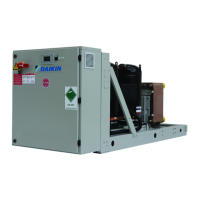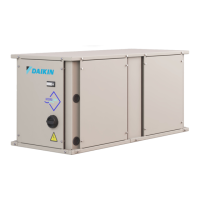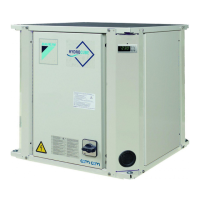EWWQ090G ÷ EWWQ720L - R410A - Water-cooled scroll chillers
EWLQ090G ÷ EWLQ720L - R410A - Condenser less
EWHQ100G ÷ EWHQ400G - R410A - Heat pump scroll chillers
EWAQ-G 075 - R410A - Air-cooled scroll chillers
EWAQ- - R410A - Air-cooled scroll chillers
EWYQ- - R410A - Air-cooled scroll heat pumps
Air and Water cooled scroll chillers & heat pump
EWWQ - EWLQ - EWHQ
EWAQ - EWYQ
Air or Water cooled scroll chiller &
heat pump
D-EOMHW00107-15EN
4.2.5.5 Timers
In this menu are reported the countdowns for startup and shutdown of a new chiller
Current delay for new chiller stage up
Current delay for new chiller stage down
4.2.6 Date/Time
This page will allow to adjust the time and date in the UC. This time and date will be used in the
alarm log. Additionally it’s also possible to set the starting and ending date for the DayLight Saving
time (DLS) if used.
DayLight Saving time start month
DayLight Saving time start week
DayLight Saving time end month
DayLight Saving time end week
On board real time clock settings are maintained thanks to a battery mounted on the controller.
Make sure that the battery is replaced regularly each 2 years (see section 3.6).
4.2.7 Power Conservation
This page resumes all the settings that allows chiller capacity limitations. For more details about
these parameters and the functions LWT Reset and Demand Limit refer to section 5.1.7.
Displays current unit capacity
Displays current demand limit
None
4-20mA
Return
OAT (A/C only)
Set leaving water temperature setpoint reset type
Refer to section
Refer to section (A/C only)
Refer to section (A/C only)
Refer to section (A/C-H/P only)
Refer to section (A/C-H/P only)
4.2.8 Controller IP setup
The UC has an embedded web server showing a replica of the onboard HMI screens. To access
this additional web HMI can be required to adjust the IP settings to match the settings of the local
network. This can be done in this page. Please contact your IT department for further information
on how to set the following setpoints.
To activate the new settings a reboot of the controller is required, this can be done with the “Apply
Changes” setpoint.
The controller also supports DHCP, in this case the name of the controller must be used.

